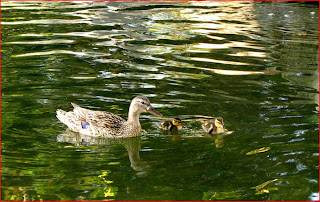Mallard Ducks

Here we are, still at the freshwater pond, with a Mallard Duck and her two babies. How do we know this duck is a female? Right, because she is brown. This coloring allows her to sit on her nest without being seen. Male Mallards have green heads. Like the turtle, Mallards will eat just about anything they can find: Small fish, clams, snails, tadpoles, worms, and plants. So, is the Mallard a carnivore, omnivore, or herbivore? If you said omnivore, you are correct. The chicks survive because they stay very close to the female. If she and the babies are approached by a predator, the mother Mallard may act like she is injured. Then the predator may focus on her and not her babies. As many as ten or twelve chicks can be born at once. They are hidden by their gold and brown colors. These ducks survive very well in many different parts of the country.
Did you find this useful? If so, you can send a "tip" to my PAYPAL.COM account. My email address is kathomatho@yahoo.com. I will donate 10% of your tip to The Orange County Zoo.


